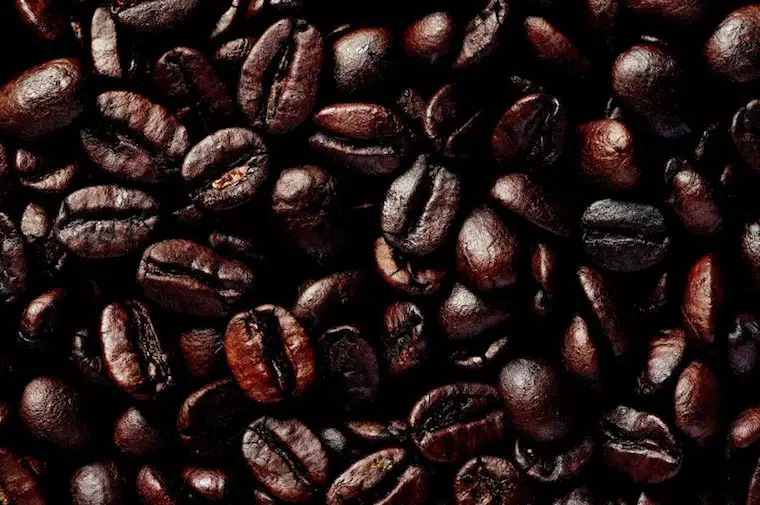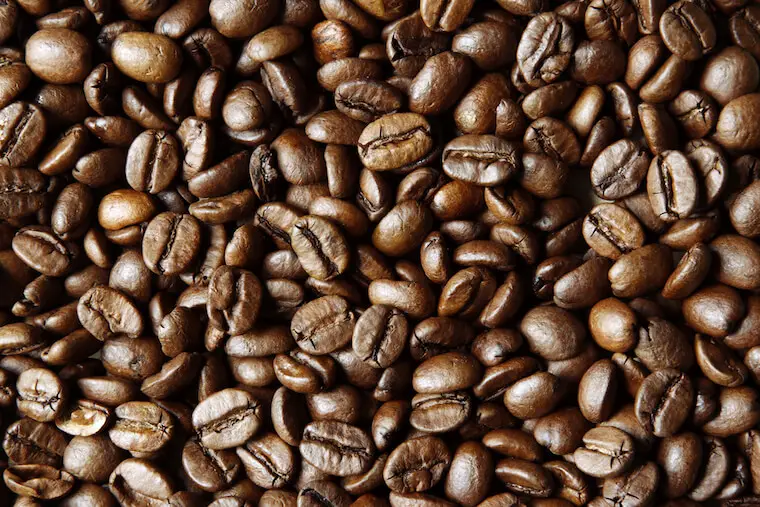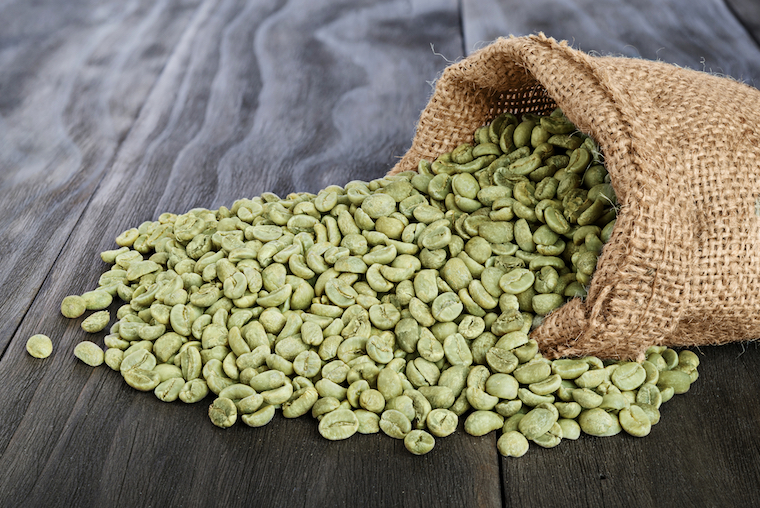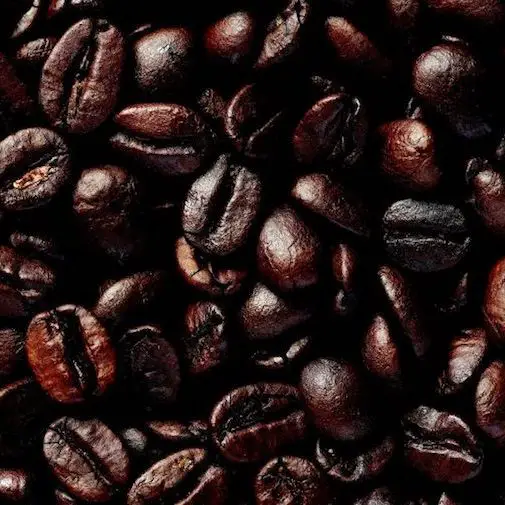Have you ever seen coffee beans that look oily? You know, when they’re a dark, dark brown. Some call them shiny. Or greasy. And it looks kinda weird, because most coffee beans look more pale and dry, don’t they? Well…
Oily coffee beans are a real thing, and there’s nothing wrong with them, either. This article will tell you what makes coffee beans oily, and whether it’s ok to use oily coffee beans for your coffee. First, let’s find out exactly what oily coffee beans are.
What are oily coffee beans?
Oily coffee beans
Do your coffee beans look like this? These are oily coffee beans. Notice how shiny they are, and how they almost look greasy. And can you see how dark they are, too? That’ll be important in just a sec.

Dry coffee beans
The opposite of oily coffee beans are dry coffee beans. Here’s a photo. These are what you’d probably call standard, normal coffee beans.

Why are my coffee beans oily? (or shiny/greasy)
Oily coffee beans comes from being roasted for a long time, so they are usually associated with dark roasts. And that’s why oily coffee beans always have a dark brown sheen to them, like they’re almost black.
This is because coffee beans contain naturally occurring oils. These oils are present, even when the coffee beans have just been picked. So like the coffee beans below, which are called “green” or “unroasted” still are just as oily as the ones above.

So what’s the difference? Well, when coffee beans are heated, these oils turn from solid to liquid and are brought to the surface of the bean.
So roasting coffee brings oil to the surface, and all roasted coffee will have some oiliness or sheen to them. The more you roast? The oilier the coffee.
(By the way, you can read ALL about roasting and light, dark and medium roasts in my comprehensive guide that’s right here.)
Is it ok for coffee beans to be oily?
There is nothing wrong with coffee beans being oily. They don’t taste worse, they’re not “off” and they’re definitely not rancid. Although they do come with one potential downside for a certain type of coffee drinker. Let me explain…
Dark roasted coffee is a little like well done steak that comes out the pan charred and lacking in flavor. It happens to coffee, too. Roast a coffee bean too much and you’ll lose its inherent flavor. So oily coffee beans are a sign that it might be lacking in flavor compared to dryer beans from a lighter roast.
Are oily coffee beans better?
Oily coffee beans are an excellent sign of good coffee because it means the coffee beans were roasted recently. Coffee beans stay fresh, and at peak flavor for only a few days. So it figures that the oiliness only stays a few days, too. Therefore, oily coffee beans are fresh coffee beans, and that’s a very good thing.
Like dark roasts? They have a unique taste that’s kinda charred and burnt. If you like that then you’ll definitely think oily coffee beans are better.
What types of coffee have oily coffee beans?
The most common type of coffee that has oily coffee beans is dark roasted coffee. A dark roast is when the coffee beans have been roasted (cooked, basically) for the longest possible time, so the most oil is brought to the surface. However, it’s not the only type…
A medium roast will have some oiliness to them. Even a light roast will have a little oil too. Green, or unroasted coffee beans won’t have any oil on the surface, they’ll feel and look completely dry.
Will oily coffee beans clog your grinder?
I have never experienced oily coffee beans clogging my grinder when I’ve been grinding normally (exception coming in a sec!) However, the oiliness or dryness of coffee beans does affect the grinding process a little. So…
Basically, dark roasts — which are oilier — are easier to grind and provide a satisfying crunch when you grind them up. Lighter roasts — more dry and less oily — are actually harder to grind and feel softer when you’re grinding. It takes longer, too.
My thinking for this is that dark roasts have the oils on the surface, which makes the beans themselves hard and brittle. You can test this by biting into any dark roast coffee beans. It’s always super hard. Lighter roasts however have the oils still inside, and so are softer. I think this is why the grinding feels a bit harder, although I wouldn’t say clogged.
Sidenote: I have clogged my grinder before, and I’m about to reveal exactly what you should NOT do to avoid it. Basically, I washed my grinder then made a coffee straight after. Didn’t give it time to dry. As a result, the ground coffee and water formed a congealed mess that took ages to get out. Couldn’t even make a coffee with it, either. Bummer.
Conclusion
So now you know. Oily coffee beans are all about how long they’ve been roasted. Actually, understanding a little about how coffee beans get roasted is a quick way to level up your coffee game. My article here is packed with stuff like this.
Likewise, now you know all about oily coffee. Do you know what happens to get sour coffee? Or why you always end up with a watery coffee? The answers might surprise you…


6 Comments
v good post. i want a coffee bean that is darkest and oiliest, spanish would perhaps be a good choice. 2 questions: what is the best bean in this category and do i lose the oil in Kcups?
The oiliest bean I’ve roasted in the ONOBEANO available from the coffee bean corral d o t c o m.
Pan roasted, over a 1/4 gas flame, shake 3x every 4 seconds; use a glass lid so you can see when you reach the oily stage, about 10 minutes. At the end of the roasting, 15 seconds too much will ruin the oil. Now, this is crucial, when you see the oil appear, put the skillet on a block of ice to shut down the roasting process. A 10″ metal cake pan works well. Take the hot glass lid off and put another on one from your freezer; turn it upside down and shake the beans against the inside of the frozen lid. There! My secret is out! I destroyed a lot of green beans before I figured this method out; drinking Kaffee in Germany in the 70’s & 80’s was a revelation.
Also, This bean makes a great tripple espresso vanilla latte.
I have solution to make a dark roasting without more bitter, very well for espresso blend , i am using hot air roasting system, only 4 minute was complete just using temperature not more 140 Celcius , if you need dark roasted been without more bitter, whatsapp me at +6285222232019
Great post very informative, I bought a new coffee at Cash and Carry (Smart Foodservice). There brand “First Street ” dark and crisp Espresso Roast whole beans, It was very dark and shinny (oily). Very different from the other brand I get at Grocery Outlet-“Running Pump Roasting Organic Peru Churupampa. Much lighter and dry. So of course I had questions, so this article was very helpful. Thanks. From Kathy in Seattle-known for its coffee consumption.
Useful article. I’ve bought a load of oily coffee beans. Good stuff but it seems to be clogging up the grinder in my bean to cup machine which is very difficult to clean. Anyone else had this problem?
I don’t know the answer, but on a video for a machine like yours from Seattle Coffee Co. website, the person said oily beans are a “no no” in those machines.